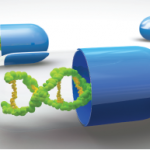Gasdermin D
Moving from lupus research to inflammasome biology, Dr. Vogel turned to a study by Tsuchiya et al.3 Using genetic knockout mice and various inflammatory stimuli and inhibitors, researchers demonstrated that gasdermin D, a pore-forming protein downstream of inflammasome activation, is necessary for the maturation and release of interleukin (IL) 1α. Gasdermin D, a mediator of pyroptosis, forms pores, allowing calcium influx into the cell. The calcium influx activates components that cleave and mature IL-1α. Then, IL-1α is able to be released through the gasdermin pore. These findings add to the growing nuance in inflammasome activation research, she added.
IL-1β
Dr. Vogel then transitioned to a study on IL-1β in a mouse model of arthritis. In an article in the Journal of Clinical Investigation, Levescot et al. looked at mice with deficiency of IL-1 receptor antagonist, a specific mouse model that develops significant erosive arthritis.4 The investigators were interested in studying the role of early anti-IL-1β therapy compared to late therapy. Early therapy resulted in effective treatment of the arthritis. Likewise, the mice that received late therapy had improvement in their clinical scores, but late initiation of therapy did not prevent bony erosions.
Interestingly, the investigators found the late-therapy mice who suffered from increased bony erosions had increased T regulatory (Treg) cells. A subset of these Treg cells were shown to promote the generation of osteoclasts, which may explain the increased presence of bony erosions. This subset of Treg cells, which the authors named O-Treg, is present in the synovium of patients with rheumatoid arthritis but not osteoarthritis, underscoring the clinical relevance of their findings.
SARS-CoV-2
Switching gears, Dr. Vogel turned to the topic of SARS-CoV-2, and she specifically highlighted a paper on primary COVID-19 infection in children vs. adults. Using single-cell RNA sequencing from nasopharyngeal cells, Loske et al. found increased numbers of immune cells in the noses of children at baseline and an enhanced innate antiviral response in early infection.5
The researchers also discovered a distinct subset of immune cells, including a cytolytic lymphocyte that expressed interferon-γ at baseline, in the noses of children. These immune cells were not present in adults. With these data, the investigators concluded these differences may explain why children seem primed to clear COVID-19 infection more quickly and effectively than infected adults.
Maternal Infection
Continuing with the theme of infections, Dr. Vogel then discussed a study by Lim et al. that describes maternal infection as a trigger for host-imprinting in the offspring.6 Using a mouse model of an attenuated Yersinia infection, researchers demonstrated that maternal infection leads to epigenetic changes in the intestinal expression of immune cells of her offspring. They also demonstrated similar changes after in utero exposure to interleukin-6 (IL-6), a proinflammatory cytokine, in the absence of infection.


